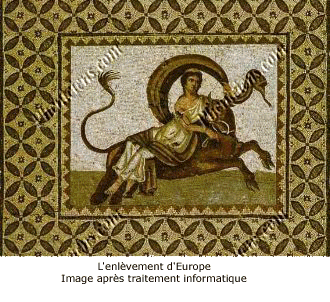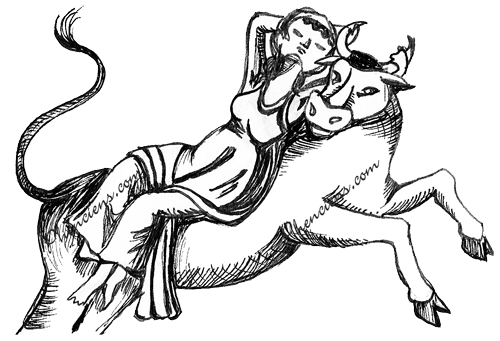
The abduction of Europe illustrated by Joelle Achkar
© Pheniciens.com
The Myth of the abduction of Europa
Over the last few years, we are witnessing on the world stage, the emergence of a new international organization: the European Union E.U., more commonly called Europe.
With the introduction of the European currency (Euro / €), Greece has chosen to mark the historicity of this event by the manufacture of a € 2 coin with the effigy of the Princess Europa, abducted by Zeus. Some questions arise: Who was this princess whom by her beauty, had dazzled the supreme god of Greek mythology? Where did she come from? What is her story and relationship with the European continent? ...
The legend spoke that Europa, a Phoenician princess, daughter of Agenor(1) king of Tyre, was walking one day along the seashore with her companions, and was noticed by Zeus. Kindled by her beauty, the God transformed himself into a white bull with a crescent moon-shaped horn and sat down at the feet of the young girl. Frightened at first, the princess grew bolder, caressed the animal and sat on his back. Immediately the bull got up and rushed towards the sea. Despite the cries of Europa, who clung to the horns, the bull stepped into the waves and moved away from the shore. They reached as far as Crete, where Zeus resumed his human appearance and mated with Europa. Out of this love, three sons born: Minos, Rhadamanthus and Sarpedon.
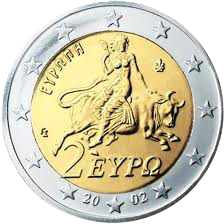
Europa, Greek Coin 2€
Following this legend was the search conducted by the brothers of the princess. The king Agenor commanded his son Cadmus to go in search for his sister, with a formal prohibition to return to Tyre, as long as he did not find her. The mother of Cadmus, Telephassa, and two of his brothers, Thassos and Cilix, accompanied him in his quest, and only Phoenix remained in the country with his father the king.
The searche of the queen and her sons was unsuccessful. Telephassa died of grief, and because of the oath to their father, the three sons dared not return home. Thassos gave up the search and went to settle in Thrace Islands, with whom he identifies himself. Cilix established himself in Cilicia, of which he was the legendary founder. As for Cadmus, he disembarked in Greece, where he interrogated the Delphic oracle, who advised him to be guided by a heifer wandering, whom he would cross on leaving the temple, and then go found a city on the very spot where it would sleep out of exhaustion. Cadmus followed the animal until the site of Thebes, and he built the citadel of Cadmea. Still hoping to find his sister, Cadmus offered to the Greeks the alphabet invented by the Phoenicians for some information about Europa. Herodotus tells the narrative as follows:
"Now these Phoenicians settled in this country of Boeotia, who came with Cadmus, of whom were the Gephyreans, brought in among the Hellenes several knowledge, and especially that of letters, which did not exist, which appears to me, among the Hellenes before this time; They first brought in those which are used generally by the Phoenician race, but afterwards, as time went on, they changed with their speech the form of the letters also. During this time the Ionians were the race of Hellenes who dwelt near them in most of the places where they were; and these, having received letters by instruction of the Phoenicians, changed their form slightly and so made use of them, and in doing so they declared them to be called "Phoenician", as was just, seeing that the Phoenicians had introduced them into Hellas." (Hérodote, II, 58).
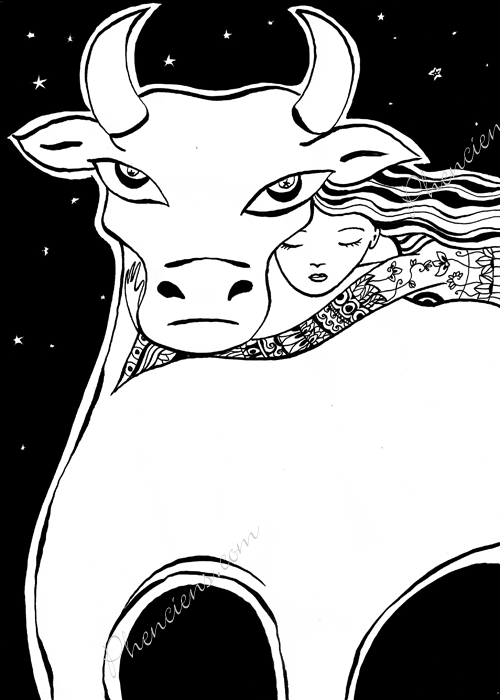
The abduction of Europe illustrated by Joelle Achkar, © Pheniciens.com
This legend of Princess Europa summarizes historical, economic and cultural realities that should correspond to the movements of civilizations homes from the Middle East to the regions of the West, which were then named "Europe".
The "Goddess and the Bull" would be illustrated on numerous occasions in sculpture, painting(2), ceramics and mosaics uptil the fourth century(3), all over the Mediterranean region (Lebanon, Greece, Italy, France, Spain, Tunisia, Algeria, ...). All of these ancient vestiges are currently preserved in the greatest museums in the world (the Louvre Museum, the Hermitage Museum, National Museum of Beirut, British Museum, the Vatican Museum, Museum of Arles and Provence Antique, Archaeological Museum Nimes, Staatliche Museen zu Berlin Museum of Palermo, Pompeii, Agora Museum in Athens, etc.).
In 1998, "La Poste" (the French Post) edited a stamp with a representation of this legend, and that during the exhibition "Liban, l’autre rive" (Lebanon, the other bank), which took place in The Arab World Institute in Paris (from October 27, 1998 to May 2, 1999).
Since 2013, the European Central Bank printed a new series of banknotes of € 5 with a hologram including a portrait of the goddess, giving rise to the "Europa series" that will concern all European banknotes. The new € 10 bill started circulating on September 23, 2014. (Photo opposite).
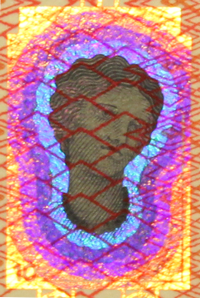
Portrait of Europa
We issue a wish to be able one day to propose via this page the history of those various representations. We invite all museums holding a piece of artwork representing the abduction of Europa to support us in this effort by participating in this project. All articles, photos, descriptions ... are welcome.
We open a lest parenthesis in this page citing the classic author Achilles Tatius (Book I, 1-1 & 1-2), observing the details of the Roman mosaic (third century), representing this kidnapping, discovered on the archaeological site of Jbeil (Byblos) and currently exhibited in the National Museum Beirut:
"Far out in the ocean was painted a bull breasting the waves, (...) The maiden sat on the middle of his back, not astride but sideways, with her feet held together on the right: with her left hand she clung to his horn, like a charioteer holding the reins, and the bull inclined a little in that direction, guided by the pressure of her hand. On the upper part of her body she wore a tunic down to her middle, and then a robe covered the lower part of her body (...). Her hands were held widely apart, the one to the bull's horn, the other to his tail and with both she held above her head the ends of her veil which floated down about her shoulders, bellying out through its whole length and so giving the impression of a painted breeze. Thus she was seated on the bull like a vessel under way, using the veil as a sail.".
| (1) |
The cities of Tyre and Sidon were able to form a political unit according to the powers that be. For this reason we read in the references, Europe daughter of the king of Tyre, or daughter of the king of Sidon. |
Retour texte |
| (2) |
Voir Christian de Bartillat & Alain Roba, Métamorphoses d'Europe, trente siècles d'iconographies, Editions Bartillat, 2000. |
Retour texte |
| (3) |
Odile Wattel-de Croizant, Les mosaïques représentant le mythe d'Europe (Ier-IVe siècles), Evolution et interprétation des modèles grecs en milieu romain, Editions De Boccard, Paris, 1995. |
Retour texte |




